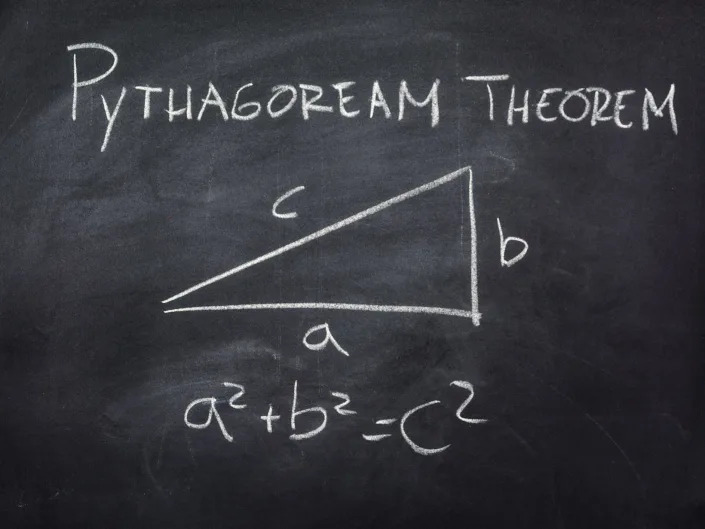
Explanation of the Pythagorean theorem drawn on a blackboard.
Getty Images
Isobel van Hagen
Sat, March 25, 2023
Two US high schoolers believe they have cracked a mathematical mystery left unproven for centuries.
Calcea Johnson and Ne'Kiya Jackson looked at the Pythagorean theorem, foundational to trigonometry.
The American Mathematical Society said the teenagers should submit their findings to a journal.
Two high school seniors from New Orleans think they have managed to prove a 2,000-year-old theorem that has stumped mathematicians for centuries.
Their work got Calcea Johnson and Ne'Kiya Jackson far enough to present their findings to researchers, per an interview with local TV earlier this week.
Their work was on the Pythagorean theorem, a staple of high school math lessons which defines the relationship between the three sides of a right-angled triangle, expressed with the formula a2+b2=c2
Although the theory holds true in every plausible example, no mathematician has been able to establish its truth from first principles, even though the theorem has been around since ancient Greek times.
Because the theorem underpins trigonometry, experts have thought it impossible to prove, since you can't use trigonometry without already accepting that the theorem is correct.
In the abstract presented by Johnson and Jackson last week, the two teenagers gestured to this, noting the book "The Pythagorean Proposition" "flatly states" that there are no trigonometric proofs because they are "based upon the truth of the Pythagorean Theorem."
They countered in their work that the claim "isn't quite true." The two claimed they were able to prove the theorem using the Law of Sines, which did not rely on circular trigonometry.
When the American Mathematical Society met in Georgia last week, Johnson and Jackson were the only high schoolers at the meeting, according to New Orleans television news station WWL.
Their claim has not gone through the rigorous academic peer-review process — or been confirmed by other experts in the field.
Catherine Roberts, executive director for the American Mathematical Society, encouraged the young mathematicians to submit their findings to a journal where it can be assessed.
She said the society "celebrates these early career mathematicians for sharing their work," The Guardian reported.
"Members of our community can examine their results to determine whether their proof is a correct contribution to the mathematics literature," Roberts said.
In an interview with WWL, the students said they were excited just to be a part of the process.
"There's just nothing like being able to do something that people don't think young people can do," Johnson said, "A lot of times you see this stuff, you don't see kids like us doing it."
Read the original article on Insider
Isobel van Hagen
Sat, March 25, 2023
Two US high schoolers believe they have cracked a mathematical mystery left unproven for centuries.
Calcea Johnson and Ne'Kiya Jackson looked at the Pythagorean theorem, foundational to trigonometry.
The American Mathematical Society said the teenagers should submit their findings to a journal.
Two high school seniors from New Orleans think they have managed to prove a 2,000-year-old theorem that has stumped mathematicians for centuries.
Their work got Calcea Johnson and Ne'Kiya Jackson far enough to present their findings to researchers, per an interview with local TV earlier this week.
Their work was on the Pythagorean theorem, a staple of high school math lessons which defines the relationship between the three sides of a right-angled triangle, expressed with the formula a2+b2=c2
Although the theory holds true in every plausible example, no mathematician has been able to establish its truth from first principles, even though the theorem has been around since ancient Greek times.
Because the theorem underpins trigonometry, experts have thought it impossible to prove, since you can't use trigonometry without already accepting that the theorem is correct.
In the abstract presented by Johnson and Jackson last week, the two teenagers gestured to this, noting the book "The Pythagorean Proposition" "flatly states" that there are no trigonometric proofs because they are "based upon the truth of the Pythagorean Theorem."
They countered in their work that the claim "isn't quite true." The two claimed they were able to prove the theorem using the Law of Sines, which did not rely on circular trigonometry.
When the American Mathematical Society met in Georgia last week, Johnson and Jackson were the only high schoolers at the meeting, according to New Orleans television news station WWL.
Their claim has not gone through the rigorous academic peer-review process — or been confirmed by other experts in the field.
Catherine Roberts, executive director for the American Mathematical Society, encouraged the young mathematicians to submit their findings to a journal where it can be assessed.
She said the society "celebrates these early career mathematicians for sharing their work," The Guardian reported.
"Members of our community can examine their results to determine whether their proof is a correct contribution to the mathematics literature," Roberts said.
In an interview with WWL, the students said they were excited just to be a part of the process.
"There's just nothing like being able to do something that people don't think young people can do," Johnson said, "A lot of times you see this stuff, you don't see kids like us doing it."
Read the original article on Insider
No comments:
Post a Comment